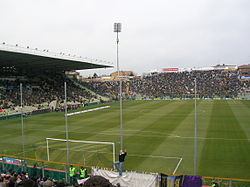Stadio Ennio Tardini
| Il Tardini | |
 |
|
| Former names | Stadio Municipale (1922–1923) |
|---|---|
| Location | Viale Partigiani d'Italia, 1 43123 Parma, Italy |
| Coordinates | 44°47′41″N 10°20′19″E / 44.79472°N 10.33861°ECoordinates: 44°47′41″N 10°20′19″E / 44.79472°N 10.33861°E |
| Owner | Municipality of Parma |
| Capacity | 27,906 (often just 22,352 allowed) |
| Field size | 105 x 68 m |
| Surface | Grass |
| Construction | |
| Broke ground | 26 December 1922 |
| Opened | 16 September 1923 |
| Renovated | 1990–1993 |
| Construction cost | ₤477,000 |
| Architect | Ettore Leoni |
| Tenants | |
|
|
|
Stadio Ennio Tardini, commonly referred to as just Il Tardini, is a football stadium in Parma, Italy, located near the centre of Parma, between the town centre and the city walls. It is the home of Parma Calcio 1913. The stadium was built in 1923 and was named after one of Parma's former presidents, Ennio Tardini. The stadium is the nineteenth largest football stadium in Italy and the second largest in Emilia–Romagna with a capacity of 22,352 spectators. The stadium is the sixth oldest Italian football ground still in use.
The ground underwent significant expansion under Parmalat's ownership of the resident football club in the 1990s, as the ground's seating capacity was increased from around 13,500 to 29,050. In 2006, the capacity was reduced to 27,906 although only 21,473 are authorised to enter for all-seater events and even those seats are very seldom all sold. The expansion has allowed meant a number of Italy matches have been played at the Tardini. Expansion plans were made public in Italy's unsuccessful bid for Euro 2016 and would have made the permanent capacity of the stadium 31,397.
The Tardini was the idea of Ennio Tardini, who was a graduate in Law and club president from 1921 to 1923, but although much of his work was political his passion was sport. In January 1922, the authorities in Parma granted Parma F.B.C. a sum of ₤10,000 and Tardini instigated a national competition for the design of the new stadium in February 1922. To raise further funds, Tardini sold a plot of land for £163,000 to the municipal administration. The club had previously had no fixed home. In September 1922, Parma's committee admitted two projects for consideration: one by Atanasio Soldati and one by Riccardo Bartolomasi, both architects working in Parma. Soldati's plans looked to architectural simplicity with classical Greek features, while Bartolomasi opted for a more convenient and modern approach.
...
Wikipedia
